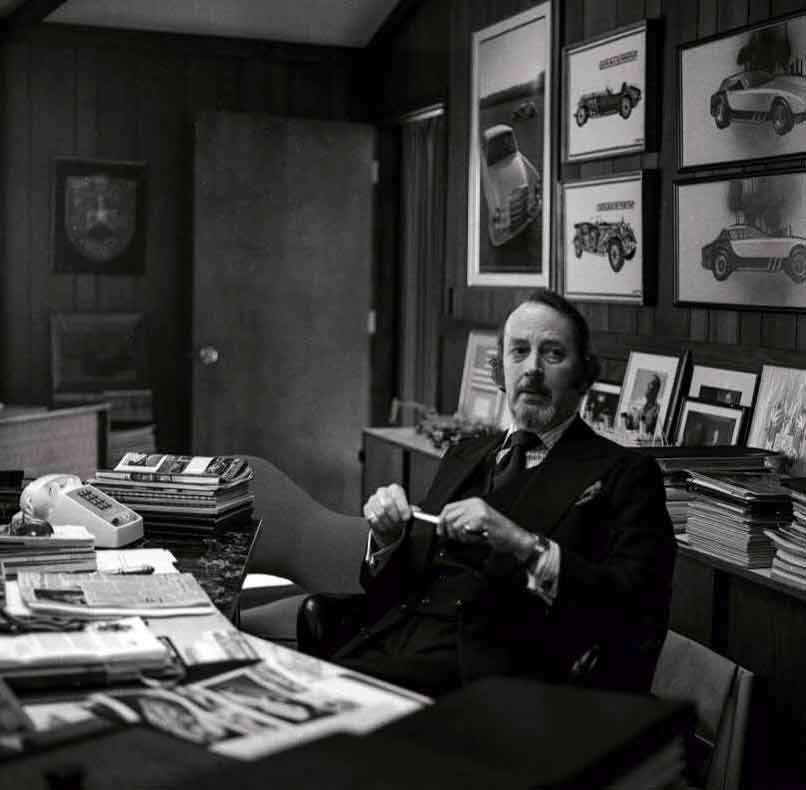This dandy of a designer created objects both influential and execrable, and coined the idea of planned obsolescence. Words Delwyn Mallet.
SUVs. Love ’em or loathe ’em, either way your thanks or opprobrium for their ever-increasing presence can be heaped upon pioneer industrial designer Brooks Stevens.

In a prescient 1942 article in Mechanix Illustrated, Stevens speculated on the form that the post-war car might take, highlighting among many other things the advantages of a rear engine location and the efficiency of small air-cooled engines. American manufacturers were not persuaded, but Stevens must have enjoyed ‘I told you so’ satisfaction after the phenomenal success of the VW Beetle. In the same article he also outlined how the Willys Jeep, the ultimate no-frills utilitarian vehicle, might be transformed into a stylish post-war ‘victory car’. In this case the management of Willys-Overland did take note.
Demand for military Jeeps collapsed after the war but Americans were clamouring for new cars. So, in 1946, Willys engaged Stevens to turn his ‘victory car’ idea into metal.
Clifford Brooks Stevens, known as ‘Kip’, was born in Milwaukee, Wisconsin, in 1911. As a child he contracted polio and, while he was confined to bed, his father encouraged him to exercise his affected right arm by drawing. Like many a youngster, Stevens became obsessed by automobiles. So much so that when studying architecture at Cornell University, he spent more time sketching cars than designing buildings and didn’t graduate.
Back in Milwaukee, Stevens put his graphic skills to work designing logos for local businesses, and eventually set up shop in 1934 as Brooks Stevens Industrial Design. His pre-war projects, mostly executed in the prevailing design idiom of ‘Streamline Moderne’, encompassed subjects as diverse as the one-off, articulated, 35ft Zephyr Land Yacht for wealthy socialite William Woods Plankinton Jr, and the Edmilton Petitpoint clothes iron with its stack of horizontal cooling fins. An example of the iron, as aesthetically satisfying as an Italian Futurist sculpture, resides at MOMA. He also introduced the glass porthole into clothes driers.
Like many of Stevens’ commissions, the Willys job came with a caveat: limited funds. Willys-Overland did not produce its own bodies and could not afford deep-draw tooling. Stevens’ solution was to use shallow pressings which mimicked the wooden frame of conventional station wagons but avoided major curves. This allowed the body to be built by suppliers more used to stamping refrigerators.
The 1946 Jeep Wagon, the first all-steel station wagon, sowed the seeds for what eventually became the Sport Utility Vehicle market. Stevens also designed the Jeepster, a roadster closer to his ‘victory car’ vision, but it was his 1962 Wagoneer that truly caught the public’s imagination. Gone were the military-style front wings and radiator grille, replaced by a full-width face and a civilised interior. The Wagoneer stayed in production for 29 years.
As a designer, Stevens was full of contradictions, his output oscillating from the refined to the outrageously vulgar. Among the 3000-plus designs that issued from his studio there were bound to be a few turkeys, the bizarre 1955 Cadillac Die Valkyrie with its astonishingly aggressive nose a prime example. Another weirdo is the Gaylord, commissioned by Gaylord brothers Jim and Ed and intended to compete with the best from Europe. In styling terms it was the automotive equivalent of the duck-billed platypus, a baffling collection of mismatched parts.
This is surprising, given that Stevens was a connoisseur of fine automotive metal, with his own motor museum to house his large collection. How someone who owned cars as exquisite as the ex-Mille Miglia Alfa Romeo 8C 2900B and a 1929 Cord L29 roadster could produce an execrable pastiche of a Mercedes- Benz SS called the Excalibur SS (not to be confused with his very butch 1951 Excalibur J racing roadster) is baffling indeed. He can however be forgiven for his involvement in the Wienermobile, a witty piece of motorised promotional kitsch in the form of a hotdog, produced for the Oscar Mayer meat company.
David E Davis Jr, the editor of Automobile magazine, best summarised Stevens when he wrote: ‘He was a fine industrial designer, but he had quirky ideas about cars. He said he was a friend of sports cars, but I said if you have a friend like that, you don’t need enemies.’
Always elegantly attired, Stevens was a true gentleman and a founding member of the Industrial Designers Society of America. While far from the first to coin the phrase, he is also credited with embedding ‘planned obsolescence’ into the marketing lexicon during a speech he delivered in 1954.
It was the concept that drove Detroit. Stevens defined it as ‘instilling in the buyer the desire to own something a little newer, a little better, a little sooner than is necessary’. It was a credo that also defined his professional life.





